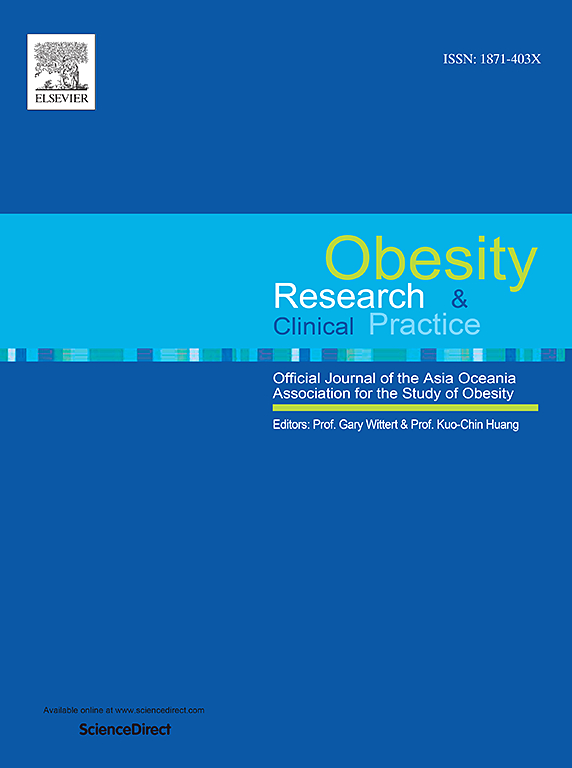Clinical characteristics affecting weight loss in an East Asian population receiving semaglutide: A STEP 6 subgroup analysis
IF 2.5
4区 医学
Q3 ENDOCRINOLOGY & METABOLISM
引用次数: 0
Abstract
Objective
To explore the effects of semaglutide versus placebo on body weight (BW) by subgroups of baseline characteristics.
Methods
In STEP 6, Japanese and Korean adults with overweight or obesity were randomized to subcutaneous semaglutide 2.4 mg, semaglutide 1.7 mg, or placebo for 68 weeks. A subset of Japanese participants with type 2 diabetes (T2D) was also included. In this post-hoc analysis, change from baseline in BW (%) was assessed by subgroups of baseline characteristics including baseline BW, body mass index, age, sex, glycemic status, dyslipidemia, and hypertension.
Results
Of 401 participants (148 female and 253 male) included, the estimated mean change in BW was clinically relevant across all subgroups for semaglutide 2.4 mg, ranging from –9.40 % to –16.42 %. Estimated treatment differences also favored both semaglutide doses versus placebo. Significant treatment-by-subgroup interactions were observed for sex with semaglutide 1.7 mg and 2.4 mg versus placebo at week 68 (p = 0.0008 and p = 0.0005, respectively). Significant treatment-by-subgroup interactions were also observed for presence of T2D and dyslipidemia at baseline, for semaglutide 2.4 mg versus placebo only (p = 0.0381 and p = 0.0181, respectively).
Conclusions
Semaglutide reduces BW in a wide demographic of people with a range of weight-related comorbidities in an East Asian population.
接受西马鲁肽治疗的东亚人群影响体重减轻的临床特征:step6亚组分析
目的:通过基线特征亚组探讨西马鲁肽与安慰剂对体重(BW)的影响。方法:在第6步中,日本和韩国超重或肥胖的成年人被随机分配到皮下塞马鲁肽2.4 mg,塞马鲁肽1.7 mg或安慰剂组,为期68周。一组患有2型糖尿病(T2D)的日本参与者也被纳入研究。在这项事后分析中,通过基线特征亚组评估基线体重(%)的变化,包括基线体重、体重指数、年龄、性别、血糖状态、血脂异常和高血压。结果:纳入的401名参与者(148名女性和253名男性)中,估计的体重平均变化在semaglutide 2.4 mg的所有亚组中均具有临床相关性,范围从-9.40 %到-16.42 %。估计的治疗差异也有利于西马鲁肽剂量和安慰剂剂量。在第68周,与安慰剂相比,semaglutide 1.7 mg和2.4 mg在性别方面观察到显著的亚组治疗相互作用(p = 0.0008和p = 0.0005)。在基线时,对于semaglutide 2.4 mg与安慰剂相比,还观察到存在T2D和血脂异常的显著亚组治疗相互作用(p = 0.0381和p = 0.0181)。结论:在东亚人群中,西马鲁肽可降低具有一系列体重相关合并症的人群的体重。
本文章由计算机程序翻译,如有差异,请以英文原文为准。
求助全文
约1分钟内获得全文
求助全文
来源期刊

Obesity research & clinical practice
医学-内分泌学与代谢
CiteScore
7.10
自引率
0.00%
发文量
80
审稿时长
49 days
期刊介绍:
The aim of Obesity Research & Clinical Practice (ORCP) is to publish high quality clinical and basic research relating to the epidemiology, mechanism, complications and treatment of obesity and the complication of obesity. Studies relating to the Asia Oceania region are particularly welcome, given the increasing burden of obesity in Asia Pacific, compounded by specific regional population-based and genetic issues, and the devastating personal and economic consequences. The journal aims to expose health care practitioners, clinical researchers, basic scientists, epidemiologists, and public health officials in the region to all areas of obesity research and practice. In addition to original research the ORCP publishes reviews, patient reports, short communications, and letters to the editor (including comments on published papers). The proceedings and abstracts of the Annual Meeting of the Asia Oceania Association for the Study of Obesity is published as a supplement each year.
 求助内容:
求助内容: 应助结果提醒方式:
应助结果提醒方式:


